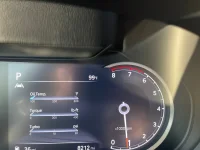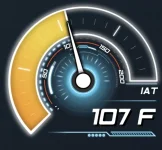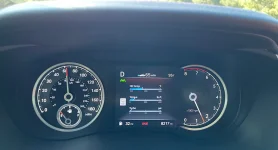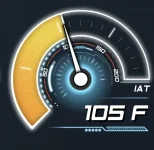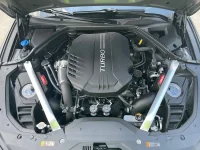Volfy
Some fava beans and a nice Chianti
- Joined
- Dec 5, 2010
- Messages
- 1,504
- Reaction score
- 1,385
- Points
- 113
- Location
- Gulf Coast
- Genesis Model Year
- 2021
- Genesis Model Type
- Genesis G70
We went for a drive in both Stinger/G70 last night, with OBD2 bluetooth adapter plugged in and displaying via Torque Pro app on smartphone. Ambient temp was around 85F. As I expected, intake manifold air temp in a turbo engine behaves quite differently compared to naturally aspirated. Here are a few observations:
1. While vehicle speed certainly did have an influence on IAT, what made the most significant difference was ENGINE RPM. The higher the RPM, the lower the IAT. The effect is almost immediate following RPM rise/fall. This is no doubt related to the long induction path of the turbo-charged engine, as the intake air, after being sucked in through the inlet air filter, must traverse through a super hot turbo charger, the intercooler, and long runs of intake plumbing (which no doubt will be warm/hot inside the engine compartment. Residence Time of the intake air, while in the intake track, determines how much heat it soaks up before entering the intake manifold (where the IAT sensor is located). Higher RPM means higher intake air volume, which means higher intake air velocity, which means lower Residence Time. Ours are 2.0T with a single turbo. Logic would dictate that the 3.3TT is likely even more affected by residence time, with two turbo chargers and correspondingly more intake plumbing.
2. Even though we couldn't measure intake air temp at the air filter inlet (not yet anyway), we could see a pronounce difference between the bone stock Stinger (except a K&N filter in stock air box), and the G70 with Injen CAI with insulation added, which does two things:
a. Shield the intake track from engine compartment heat
b. Force the intake to draw air from either the stock air inlet port or the wheel well cavity, both of which are essentially at ambient temp.
Driven back to back, with the exact same OBD2 display, the Stinger recorded a typical low RPM (sub 1500RPM) IAT of around 114-116F. Changing gears at the same vehicle speed (~40mph) and raise the RPM to some 3000RPM, IAT dropped to 107-109F.
With the G70 at similar vehicle speed (~40mph), sub 1500RPM IAT was 109-111F. Raising the RPM (3000+) brought IAT down to 95-98F.
Clearly, the Cold Air Intake does make a remarkable difference. I only wish we had done this test prior to adding the radiant barrier insulation to the Injen intake system. We will get to do exactly that next month, since we have to remove the Injen CAI and put the stock intake back on for the AutoX event on July 10. After that, we will re-install the Injen CAI and have a chance to repeat the test again. I'm frankly not optimistic that the naked Injen system, even with the "heat shield" in place, will perform as well as being fully insulated/isolated. Air flow is lazy and will take the path of least resistance. With still so much open path to suck in underhood hot air, there is no incentive for the open cone filter to draw colder air from outside the engine compartment. While the bling factor is nice, I care much more about whether the Cold Air Intake actually does what its namesake promises. The potential is there. As delivered, however... meh. Sometimes, the modification requires, uh, modification.
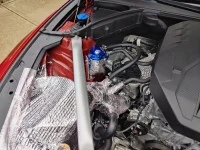
1. While vehicle speed certainly did have an influence on IAT, what made the most significant difference was ENGINE RPM. The higher the RPM, the lower the IAT. The effect is almost immediate following RPM rise/fall. This is no doubt related to the long induction path of the turbo-charged engine, as the intake air, after being sucked in through the inlet air filter, must traverse through a super hot turbo charger, the intercooler, and long runs of intake plumbing (which no doubt will be warm/hot inside the engine compartment. Residence Time of the intake air, while in the intake track, determines how much heat it soaks up before entering the intake manifold (where the IAT sensor is located). Higher RPM means higher intake air volume, which means higher intake air velocity, which means lower Residence Time. Ours are 2.0T with a single turbo. Logic would dictate that the 3.3TT is likely even more affected by residence time, with two turbo chargers and correspondingly more intake plumbing.
2. Even though we couldn't measure intake air temp at the air filter inlet (not yet anyway), we could see a pronounce difference between the bone stock Stinger (except a K&N filter in stock air box), and the G70 with Injen CAI with insulation added, which does two things:
a. Shield the intake track from engine compartment heat
b. Force the intake to draw air from either the stock air inlet port or the wheel well cavity, both of which are essentially at ambient temp.
Driven back to back, with the exact same OBD2 display, the Stinger recorded a typical low RPM (sub 1500RPM) IAT of around 114-116F. Changing gears at the same vehicle speed (~40mph) and raise the RPM to some 3000RPM, IAT dropped to 107-109F.
With the G70 at similar vehicle speed (~40mph), sub 1500RPM IAT was 109-111F. Raising the RPM (3000+) brought IAT down to 95-98F.
Clearly, the Cold Air Intake does make a remarkable difference. I only wish we had done this test prior to adding the radiant barrier insulation to the Injen intake system. We will get to do exactly that next month, since we have to remove the Injen CAI and put the stock intake back on for the AutoX event on July 10. After that, we will re-install the Injen CAI and have a chance to repeat the test again. I'm frankly not optimistic that the naked Injen system, even with the "heat shield" in place, will perform as well as being fully insulated/isolated. Air flow is lazy and will take the path of least resistance. With still so much open path to suck in underhood hot air, there is no incentive for the open cone filter to draw colder air from outside the engine compartment. While the bling factor is nice, I care much more about whether the Cold Air Intake actually does what its namesake promises. The potential is there. As delivered, however... meh. Sometimes, the modification requires, uh, modification.

Last edited:



